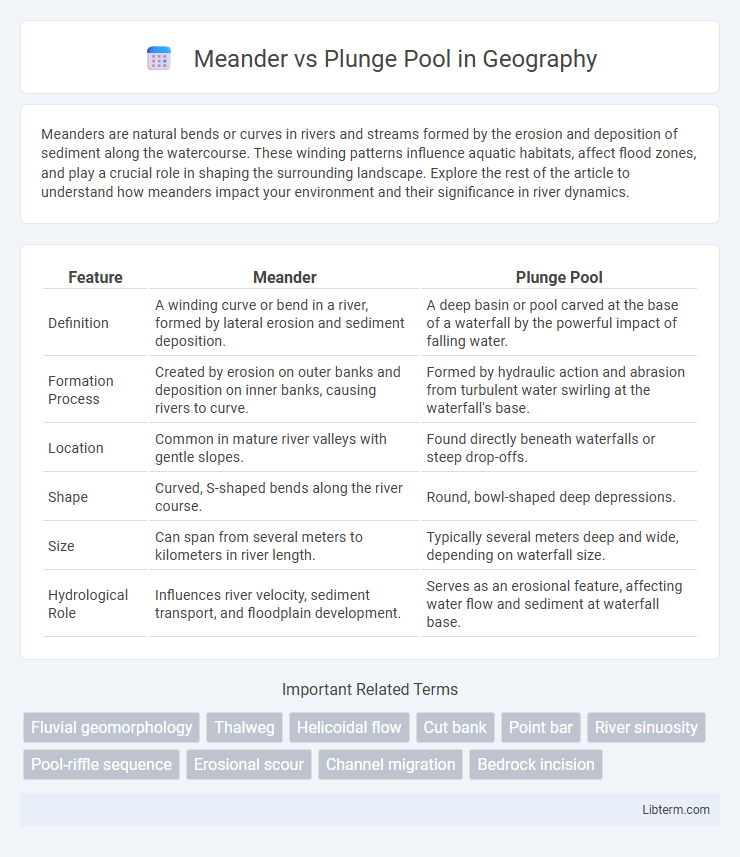Meanders are natural bends or curves in rivers and streams formed by the erosion and deposition of sediment along the watercourse. These winding patterns influence aquatic habitats, affect flood zones, and play a crucial role in shaping the surrounding landscape. Explore the rest of the article to understand how meanders impact your environment and their significance in river dynamics.
Table of Comparison
| Feature | Meander | Plunge Pool |
|---|---|---|
| Definition | A winding curve or bend in a river, formed by lateral erosion and sediment deposition. | A deep basin or pool carved at the base of a waterfall by the powerful impact of falling water. |
| Formation Process | Created by erosion on outer banks and deposition on inner banks, causing rivers to curve. | Formed by hydraulic action and abrasion from turbulent water swirling at the waterfall's base. |
| Location | Common in mature river valleys with gentle slopes. | Found directly beneath waterfalls or steep drop-offs. |
| Shape | Curved, S-shaped bends along the river course. | Round, bowl-shaped deep depressions. |
| Size | Can span from several meters to kilometers in river length. | Typically several meters deep and wide, depending on waterfall size. |
| Hydrological Role | Influences river velocity, sediment transport, and floodplain development. | Serves as an erosional feature, affecting water flow and sediment at waterfall base. |
Introduction to River Landforms
Meanders are winding bends in a river formed by the lateral erosion and deposition processes along the riverbank, creating features such as slip-off slopes and point bars. Plunge pools are deep, basin-like depressions found at the base of waterfalls where the force of falling water erodes the riverbed through hydraulic action and abrasion. Both meanders and plunge pools exemplify dynamic river landforms shaped by water flow velocity, sediment transport, and erosion patterns within fluvial environments.
What is a Meander?
A meander is a naturally occurring, winding curve or bend in a river or stream formed by the water's erosion of the outer banks and deposition along the inner banks, creating a sinuous path. Meanders play a crucial role in slowing water flow, promoting sediment deposition, and supporting diverse aquatic habitats. Unlike plunge pools, which are deep basins formed at the base of waterfalls by vertical water erosion, meanders develop primarily through lateral erosion in flatter landscapes.
What is a Plunge Pool?
A plunge pool is a small, deep swimming pool designed primarily for relaxation and hydrotherapy rather than extensive swimming. It typically features a compact size with a depth ranging from 6 to 9 feet, allowing users to immerse and cool off quickly. Unlike meander pools that emphasize winding pathways and gradual movement, plunge pools maximize space efficiency and water depth for a concentrated, refreshing experience.
Geographical Formation of Meanders
Meanders form in river landscapes where water flows over relatively flat terrain, causing the river to develop sinuous curves due to lateral erosion and deposition processes. These bends increase in size as erosion occurs on the outer banks and sediment accumulates on inner banks, creating distinctive looping patterns. In contrast, plunge pools are deep basins formed at the base of waterfalls through vertical erosion driven by the force of falling water.
Formation Process of Plunge Pools
Plunge pools form through intense hydraulic action as water falls vertically, eroding bedrock at the base of waterfalls or rapids. This process involves the scouring force of turbulent water and transported sediments, deepening the pool by abrasion and cavitation. In contrast, meanders evolve laterally due to sediment deposition and erosion along river bends, shaping sinuous curves rather than deep basins.
Key Differences Between Meanders and Plunge Pools
Meanders are winding, shallow channels formed by the lateral erosion and deposition of sediment in rivers, characterized by their curved paths and gentle slopes. Plunge pools are deep, circular basins created by the forceful impact of water plunging over a waterfall, resulting in intense vertical erosion. Key differences include their formation processes, with meanders shaped by gradual sediment movement and plunge pools formed by concentrated hydraulic energy.
Role in River Erosion and Deposition
Meander formations play a crucial role in river erosion by eroding the outer banks through lateral erosion while depositing sediments on the inner banks, promoting river channel migration and floodplain development. Plunge pools, formed at the base of waterfalls, focus on vertical erosion by scouring the riverbed through hydraulic action, deepening the river channel and enhancing sediment transport downstream. Both features contribute to shaping river landscapes, with meanders influencing lateral deposition patterns and plunge pools intensifying vertical erosion processes.
Ecological Importance of Meanders and Plunge Pools
Meanders play a crucial ecological role by creating diverse habitats that support a wide range of aquatic and terrestrial species through their slow-moving waters and nutrient-rich sediments. Plunge pools, formed at the base of waterfalls, provide unique microhabitats with high oxygen levels and cooler temperatures, essential for certain fish and invertebrates. Both features contribute significantly to biodiversity and the health of freshwater ecosystems by enhancing habitat complexity and water quality.
Examples of Famous Meanders and Plunge Pools
Famous meanders such as the Horseshoe Bend in Arizona and the Rhine River meanders in Germany showcase the distinctive looping patterns formed by river erosion and deposition. Iconic plunge pools like the Devil's Pool at Victoria Falls in Zambia and the Blue Hole in Jamaica demonstrate powerful erosive forces where waterfalls create deep, circular basins at their bases. These natural formations highlight contrasting fluvial processes that shape river landscapes around the world.
Conclusion: Comparing Meanders and Plunge Pools
Meanders provide gentle curves and naturalistic flow ideal for creating tranquil garden streams, enhancing biodiversity and visual appeal. Plunge pools offer deep, compact basins designed for relaxation and water-based recreation, serving as urban oases in limited spaces. Selecting between meanders and plunge pools depends on the desired function, spatial constraints, and aesthetic goals of the landscape design.
Meander Infographic

 libterm.com
libterm.com